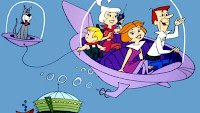That being said, in lecture Professor Vesna mentioned a video called "The Pale Blue Dot" made by Carl Sagan. Within the video, it shows the furthest picture of Earth that has ever been taken. Mr. Sagan talks about how everything that has occurred on Earth is basically insignificant to the entire Universe. He says that "...the earth is a small stage in a vast cosmic arena..." But one of the points that resonated with me the most can be related to the arms race during the cold war. The United States and the Soviet Union were pursuing "...glory and triumph so they can become the momentary masters of a fraction of a dot..." This really shows how insignificant is retrospect, but how important our Earth really is to us as its inhabitants. It puts into perspective the amazing capabilities that human beings have, and how quickly everything that we love can be taken away from us.
The way that this video is made can also be related to the Leonardo Space Art reading. Within the reading, it is said that "...discovering the history of space art, I came to understand that artists have been the fuel of space exploration, embodying in their art the dreams of humankind, making these dreams desirable for engineers to achieve." Obviously without the developments made and being made in science, technology, and math the exploration of space would not be possible. But I am a firm believer that without the wonder, curiosity and desire of artists, the motivation to explore the vast and infinite unknown would not be done with the same passion.
Works Cited
“A Pale Blue Dot.” A Pale Blue Dot. N.p., n.d. Web. 31 May 2015. <http://www.bigskyastroclub.org/pale_blue_dot.html>.
Malina, Roger, Arthur Woods, Annick Bureaud, and B.E. Johnson. "Leonardo Space Art Project Visioneers." Leonardo Space Art Project Visioneers. MIT Press, n.d. Web. 31 May 2015.
Peljhan, Marko. "CODED UTOPIA." Continental Drift. N.p., 27 Mar. 2007. Web. 31 May 2015.
UWM Graphic Design Capstone 2010. “Based on Soviet space propaganda.” UMW Graphic Design Capstone 2010. Blogger, 16 Nov. 2010. Web. 27 May 2015.
Vesna , Victoria, dir. Space Part 1. 2015. Film. 31 May 2015.
Vesna , Victoria, dir. Space Part 3. 2015. Film. 31 May 2015.
Vesna , Victoria, dir. Space Part 4. 2015. Film. 31 May 2015.
Vesna , Victoria, dir. Space Part 5. 2015. Film. 31 May 2015.
Pictures
http://blogs.scientificamerican.com/life-unbounded/return-to-the-pale-blue-dot/
http://en.wikipedia.org/wiki/Star_Trek:_The_Original_Series
http://www.cbsnews.com/news/the-retro-future-of-the-jetsons/
http://en.wikipedia.org/wiki/Nuclear_weapon
https://www.pinterest.com/sherrystjohn/renaissance-art/
http://en.wikipedia.org/wiki/The_Starry_Night














.jpeg)
